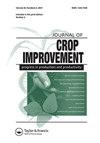Variation among sorghum genotypes for reduction in popping caused by threshing-induced kernel damage
IF 1.5
Q3 AGRONOMY
引用次数: 0
Abstract
ABSTRACT Interest has increased in pop sorghum (Sorghum bicolor (L.) Moench) as an alternative to popcorn as an ingredient in snack foods and as a confectionary snack per se. However, studies on the effect of sorghum genotype, agronomic production and grain processing on popping quality are limited and this has hindered the development of sorghum hybrids specifically for popping. This study assessed the effects of sorghum genotypes, threshing methods, environments and their interactions on sorghum popping quality. Grain from six sorghum genotypes previously documented to have good popping quality was produced in two Texas environments and was threshed using five methods which were expected to cause varying levels of kernel damage. Popping quality, measured as popping efficiency, expansion ratio and flake size was influenced primarily by threshing method, sorghum genotype and to a lesser extent by environment and the genotype × threshing method interaction. The results herein indicate that threshing methods can significantly reduce popping quality and that sorghum genotypes differ in their inclination to threshing-induced kernel damage. Based on these results, popping quality in sorghum is optimized by selecting genotypes for high popping quality and threshing the grain using a method that inflicts minimal damage to the kernel. Abbreviations: ER, Expansion Ration; FS, Flake Size; KHI, Kernel Hardness Index; PE, Popping Efficiency; TKW, Thousand Kernel Weight; UPK, Un-popped Kernels高粱基因型间减少脱粒致裂的变异
人们对流行高粱(sorghum bicolor, L.)的兴趣日益浓厚。作为爆米花的替代品,作为零食和糖果零食的一种成分。然而,关于高粱基因型、农艺生产和粮食加工对爆穗品质影响的研究有限,这阻碍了爆穗专用高粱杂交种的开发。研究了高粱基因型、脱粒方式、环境及其相互作用对高粱脱粒品质的影响。在德克萨斯州的两种环境中生产了先前记录的具有良好爆裂品质的六种高粱基因型的籽粒,并使用五种方法进行了脱粒,这些方法预计会造成不同程度的籽粒损伤。脱粒质量主要受脱粒方式、高粱基因型的影响,其次受环境和基因型与脱粒方式的交互作用的影响。结果表明,不同的脱粒方式会显著降低籽粒品质,不同的高粱基因型对脱粒损伤的倾向不同。在此基础上,通过选择高爆粒品质基因型和采用对籽粒损害最小的脱粒方法,对高粱爆粒品质进行优化。缩写:ER,膨胀比;FS:片状粒度;核硬度指数;PE:发泡效率;千粒权TKW;UPK,未爆玉米粒
本文章由计算机程序翻译,如有差异,请以英文原文为准。
求助全文
约1分钟内获得全文
求助全文
来源期刊

Journal of Crop Improvement
Multiple-
CiteScore
3.30
自引率
7.70%
发文量
42
期刊介绍:
Journal of Crop Science and Biotechnology (JCSB) is a peer-reviewed international journal published four times a year. JCSB publishes novel and advanced original research articles on topics related to the production science of field crops and resource plants, including cropping systems, sustainable agriculture, environmental change, post-harvest management, biodiversity, crop improvement, and recent advances in physiology and molecular biology. Also covered are related subjects in a wide range of sciences such as the ecological and physiological aspects of crop production and genetic, breeding, and biotechnological approaches for crop improvement.
 求助内容:
求助内容: 应助结果提醒方式:
应助结果提醒方式:


